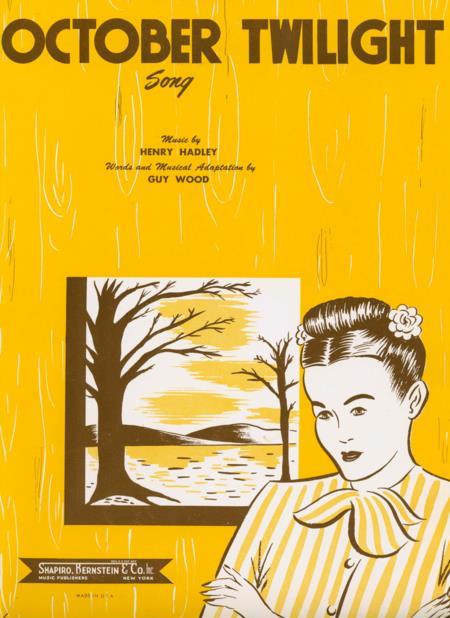October Twilight
under construction
October Twilight - first published as a piano solo in 1922 and not known yet in any such recordings - became, long after Hadley's death, the enduring universal popular song hit that the appears to have hoped to find in some of his work. It is interesting to compare his sucess in this way with George Gershwin. (It is also tempting in our era to compare their relative sucess in the field of opera - but it is worth remembering that Gershwin's Porgy and Bess took a long and indirect path to its present position).
An organ transcription of October Twilight, By Earl R. Larson, was copyrighted by Carl Fischer in 1937.
Probably always beloved as a beautiful melody, Twilight's rise to become a pop standard appears to really begin in 1940 when Victor Records released a performance of Hadley's 1936 Concertino for Piano and Orchestra. The Concertino, a dense classical piece requiring repeated, more than average concentration from the listener, carried over to the second side of a ten-inch shellac 78 rpm disk. Remaining space on the second side was alloted to an orchestration of the beautiful, romantic, melodic October Twilight. It isn't known how well the record sold, or how often Concertino was enjoyed in listener's homes - many times by sophisticated listeners, one would hope - but this must have helped Twilight must have come to the attention of adapters of classical themes to popular purposes.
Time Magazine reviewed the release in its Monday, Feb. 05, 1940 issue: Hadley: Concertino for Piano and Orchestra (Victor Symphony Orchestra. Philip James conducting, with Eunice Howard; Victor: 3 sides). A warmhearted gentleman who spent much of his life applauding the music of other U. S. composers, the late Henry Hadley himself wrote well-tailored, gentlemanly music. Up to now, none of it has been recorded. Warmer and more interesting than his Brahmsian Concertino is the little semi-popular piece October Twilight, which fills out this album's fourth side.
In 1947, British dance band saxophonist and songwriter Guy Wood created lyrics (copyrighted in 1948) adapted the melody and American big band leader Franke Carle released it with singer Nan Wright. It has remained one of his very popular recordings, re-released on LP on his "The Very Best of the Columbia Years" album, passing its seventieth year of availability in 2017. It was also recorded by British singer Eric Whiteley at this time. Guy Wood's vocal arrangement was published as sheet music in American and British editions.
In the September 25, 1948 issue of Billboard, p. 33, the Disk Jockeys' picks listed October Twilight as number nine out of the top ten predicted picks for the following week.
Other recordings of October Twilight include:
1948 - Steve Conway in a vocal addition on English, Columbia Records F.B. 3416, and later re-released on LP in "The Very Best of Steve Conway".
dates to be determined: Joe Loss and his Orchestra recorded a 78 rpm version on Britsh His Master's Voice, B.D. 6015
Geraldo and his Orchestra (vocalist: Lewis) 78 rpm on Parlophone F. 2306 (and apparently in various LP re-releases)
1953 Ralph Sharon recorded a version of Twilight.
1961 - Ralph Flanagan's Orchestra dance band in an instrumental version.
date unknown: an organ recording, possibly of the 1937 arrangement, by Arnold Loxham on "The Four Seasons of Blackpool" ("Organ1stRadio", #112 Nov. 2016, 18:30)
2017 (approx) Rodney Sauer released a new recording with his Monte Alto Motion Picture Orchestra, a silent film accompaniment and recording chamber orchestra. Sauer's recording was used in a new release of the 1930 PEOPLE ON SUNDAY (Menschen am Sonntag, 1930), and also separately as a disk of silent film music (it is to be confirmed whether Twilight was ever released or called for in cue sheet form. It might well have been used informally of course).




